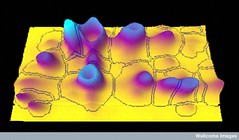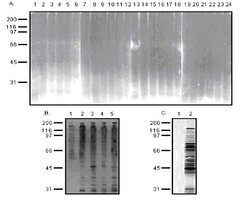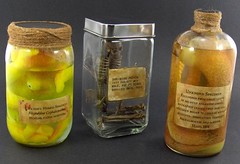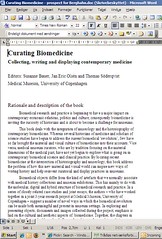Just a few words about the upcoming conference ‘The Exhibition as Product and Generator of Scholarship’ at Deutsches Museum in Munich, 27-28 November 2008 — a follow-up on the conference Research and Museums that was held in Stockholm in May last year.
It will be an interesting conference because — by bringing together exhibition makers, museum experts, designers, artists, cultural studies scholars and historians of science and technology — it addresses the core issue in our work here at Medical Museion, namely, the interplay between research and museum work. Two of us (Martha and myself) will present papers.
The motto of the meeting is: “No exhibition without scholarship”. In other words: museum exhibitions aren’t just about visualizing results of historical and other kinds of museum-relevant research results; they also stimulate academic scholarship and generate new research question and new knowledge:
How can researchers take advantage of this opportunity? In which way can scholarly arguments be translated into spatial arrangement and at the same time kept serviceable for reading and citing by later recipients? What might the results of the scholarly examination of an exhibition look like? Unlike for printed texts, the traditional publication media of scholarship, common standards of terminology and argumentation for exhibitions have yet to emerge. What exactly is the role of the objects on display? Recent history of science and technology has intensively interrogated the epistemic quality of these material sources of research. Yet how do the objects unfold their properties in being staged for exhibition purposes?
Sessions:
1) What is this thing called exhibition? Reflections on object, text and space
- Ulrich Raulff (Marbach), Old answers, new questions: What do exhibitions really produce?
- Jochen Brüning (Berlin), Exhibitions vs. publications. On scientific achievements and their evaluation
- Martha Fleming (Copenhagen/Toronto), Thinking through objects
- Commentary: Lorraine Daston (Berlin)
2) Stories on display. What and how do we see in exhibitions?
- Uwe W. Brückner (Stuttgart), Scenography – opera as model for integrative design
- Stefan Iglhaut (Berlin), Story telling and scenography: Strategies of science communication in exhibitions
- Commentary: Anke te Heesen (Tübingen)
3) History of science, objects, exhibitions: Interrelations, transitions, transformations
- Hans-Jörg Rheinberger (Berlin), Making visible. Visualization in the sciences – and in exhibitions?
- Ulrich Großmann (Nuremberg), The Challenge of Objects – CIHA Congress 2012. The object in the focus of arthistorical studies
- Thomas Söderqvist (Copenhagen), Do things talk?
- Commentary: Falk Müller (Frankfurt)
4) More than history of science?! Exhibitions, research, and the public
- Mosbrugger (Frankfurt/M.), Natural history research and exhibitions – a hermeneutical cycle
- Robert Bud (London), Power, belief and trust: a context for scholarly priorities in the history of science
- Ad Maas (Leiden), Tearing down the altar. A new view of displaying scientific intruments in Museum Boerhaave
- Commentary: Jochen Hennig (Berlin)
5) Making exhibitions: Concepts, constraints, critique
- Jürgen Renn (Berlin), Exhibitions as history of science in action
- Walter Hauser (Munich), Artefacts, visuals and topography as evidence: Working on an exhibition on nano- and biotechnology
- Thomas Schnalke (Berlin), Arguing with objects. The exhibition as a scientific format of publication
- Commentary: Karsten Gaulke (Kassel)
The conference is organised for the Max Planck Research Network ‘The History of Scientific Objects’ by Helmuth Trischler, Christian Sichau and Susanne Pickert at Deutsches Museum. You are welcome to contact Susanne Pickert at s.pickert@deutsches-museum.de if you want to attend.


 It allows you to find the image content of (presently) some 35,000 open access articles from
It allows you to find the image content of (presently) some 35,000 open access articles from  Ever thought about building your own collection of medical wet specimens? Spending your evenings and gloomy sleepless nights in the garage putting your family’s and friends’ pickled organs and body parts in jars? Founding a clandestine horror show?
Ever thought about building your own collection of medical wet specimens? Spending your evenings and gloomy sleepless nights in the garage putting your family’s and friends’ pickled organs and body parts in jars? Founding a clandestine horror show?
 No, it’s not spaghetti waiting to be served in the Medical School cafeteria — it’s intestinal worms (
No, it’s not spaghetti waiting to be served in the Medical School cafeteria — it’s intestinal worms ( Like many of our readers, the Biomedicine of Display blog team is taking some break periods here in August.
Like many of our readers, the Biomedicine of Display blog team is taking some break periods here in August.